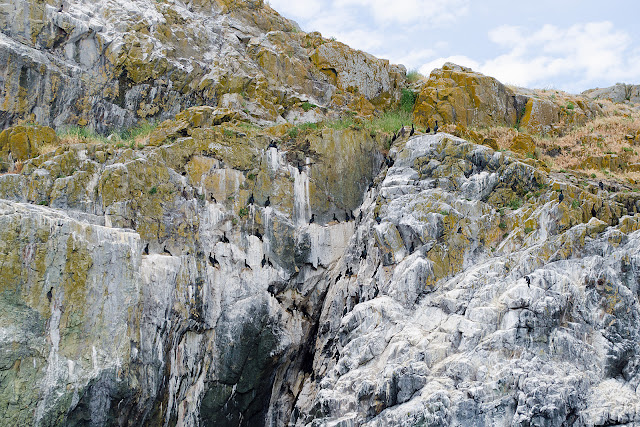The southern coast of Mitlenatch Island is all high basaltic cliffs, streaked white by cormorant guano, painted along the upper edges with a yellow lichen that feeds on the guano. Along the top and sheer sides of the rock walls, hundreds of cormorants make their nests. From our viewpoint, down in the dinghy at a good 50 metres offshore, they seemed like punctuation marks; exclamation points emphasizing the verticalness of the rock face.
 |
| Distant view |
 |
| We came in closer. The cormorants are still mere specks. |
The pelagic cormorants are the smaller of the two cormorants we saw. They are a glossy black, sometimes iridescent when the light is right. In breeding plumage (like now) they have a small red patch on the throat, and two small feather crests on the head, hard to see at this distance. Breeding adults also have a large white flank patch, and these are visible, even in these small photos.
The nests here are visible as yellowish brown spots beneath some of the cormorants.
 |
| Zoomed and cropped photo. Besides the obvious nesting site, look more closely at the sheer walls. These birds nest on bumps that seem only big enough to hold their feet. |
 |
| Moving on down the coast. Pelagics crowded together in the centre. On the top of the hill to the left, double-crested cormorants have their nests. |
 |
| More pelagics. The white patches are visible, and with the photo at full size, a bit of the iridescence is apparent. |
 |
| Skimpy nests. It's a wonder the eggs don't roll off with the merest gust of wind. But the chicks here are at least safe from predators. |
 |
| Here, the only cormorants with nests are the couple of pairs part way down the cliff face, on tiny ledges. (Click for full size view.) The ones on top are nestless. On the left three juveniles are a lighter colour. |
The double-crested cormorant is a larger bird than the pelagic. They are a dull black, but have a large orange or yellow throat patch, visible even from this distance without a zoom lens. In breeding season, they develop a double feather crest, larger than that of the pelagics. In this photo (click) I can see it, barely, on three or maybe four of them.
 |
| Pelagics again. A few red patches visible. |
As we left the cormorants behind on our circuit of the island, we came upon the sea lions. Next.
(8th in a series of 9 Mitlenatch Island posts.
#1,
#2,
#3,
#4.
#5.
#6,
#7.)











Neat series of cliff and bird pictures!
ReplyDelete